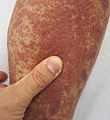Cutaneous small-vessel vasculitis (also known as "Cutaneous leukocytoclastic angiitis,"[1] "Cutaneous leukocytoclastic vasculitis,"[1] "Cutaneous necrotizing venulitis,"[1] and "Hypersensitivity angiitis"[1]) is inflammation of small blood vessels (usually post-capillary venules in the dermis), characterized by palpable purpura.[2]:831[3] It is the most common vasculitis seen in clinical practice. Leukocytoclasis refers to the damage caused by nuclear debris from infiltrating neutrophils in and around the vessels.[4]
Subtypes of small-vessel vasculitis include:[2]:833-6
Leukocytoclastic vasculitis
See also
References
- ↑ 1.0 1.1 1.2 1.3 Rapini, Ronald P.; Bolognia, Jean L.; Jorizzo, Joseph L. (2007). Dermatology: 2-Volume Set. St. Louis: Mosby. ISBN 1-4160-2999-0.
- ↑ 2.0 2.1 James, William D.; Berger, Timothy G.; et al. (2006). Andrews' Diseases of the Skin: clinical Dermatology. Saunders Elsevier. ISBN 0-7216-2921-0.
- ↑ Lotti T, Ghersetich I, Comacchi C, Jorizzo JL (November 1998). "Cutaneous small-vessel vasculitis". J. Am. Acad. Dermatol. 39 (5 Pt 1): 667–87; quiz 688–90. doi:10.1016/S0190-9622(98)70039-8. PMID 9810883.
- ↑ Harrison's Principles of Internal Medicine. 18th edition. Page 2798.
|
|---|
| | Large vessel | |
|---|
| | Medium vessel | |
|---|
| | Small vessel |
|
|---|
| | Other | |
|---|
|
|
anat (a:h/u/t/a/l,v:h/u/t/a/l)/phys/devp/cell/prot
|
noco/syva/cong/lyvd/tumr, sysi/epon, injr
|
proc, drug (C2s+n/3/4/5/7/8/9)
|
|
|
|



